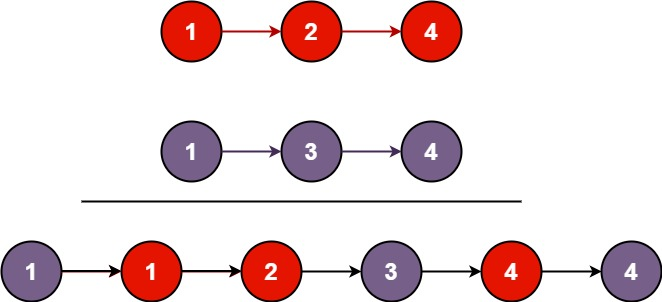题目
将两个升序链表合并为一个新的 升序 链表并返回。新链表是通过拼接给定的两个链表的所有节点组成的。

示例 1:
输入:l1 = [1,2,4], l2 = [1,3,4]
输出:[1,1,2,3,4,4]
示例 2:
输入:l1 = [], l2 = []
输出:[]
示例 3:
输入:l1 = [], l2 = [0]
输出:[0]
提示:
- 两个链表的节点数目范围是 [0, 50]
- -100 <= Node.val <= 100
- l1 和 l2 均按 非递减顺序 排列
链接:https://leetcode-cn.com/leetbook/read/top-interview-questions-easy/xnnbp2/
来源:力扣(LeetCode)
代码
/**
* Definition for singly-linked list.
* public class ListNode {
* int val;
* ListNode next;
* ListNode() {}
* ListNode(int val) { this.val = val; }
* ListNode(int val, ListNode next) { this.val = val; this.next = next; }
* }
*/
class Solution {
public ListNode mergeTwoLists(ListNode l1, ListNode l2) {
if (l1==null||l2==null) return l2==null ? l1:l2;
ListNode tmp =l1;//l1插入l2
while(tmp!=null){
l2=ckadd(tmp,l2);
tmp =tmp.next;
}
return l2;
}
ListNode ckadd(ListNode node,ListNode l2){
ListNode mm=new ListNode(0,l2);
ListNode fh=mm;
while(node.val>l2.val){
mm=l2;
l2=l2.next;
if(l2==null){
mm.next=new ListNode(node.val,null);
return fh.next;
}
}
mm.next=new ListNode(node.val,l2);
return fh.next;
}
}
递归方式
public ListNode mergeTwoLists(ListNode linked1, ListNode linked2) {
//只要有一个为空,就返回另一个
if (linked1 == null || linked2 == null)
return linked2 == null ? linked1 : linked2;
//把小的赋值给first
ListNode first = (linked2.val < linked1.val) ? linked2 : linked1;
first.next = mergeTwoLists(first.next, first == linked1 ? linked2 : linked1);
return first;
}